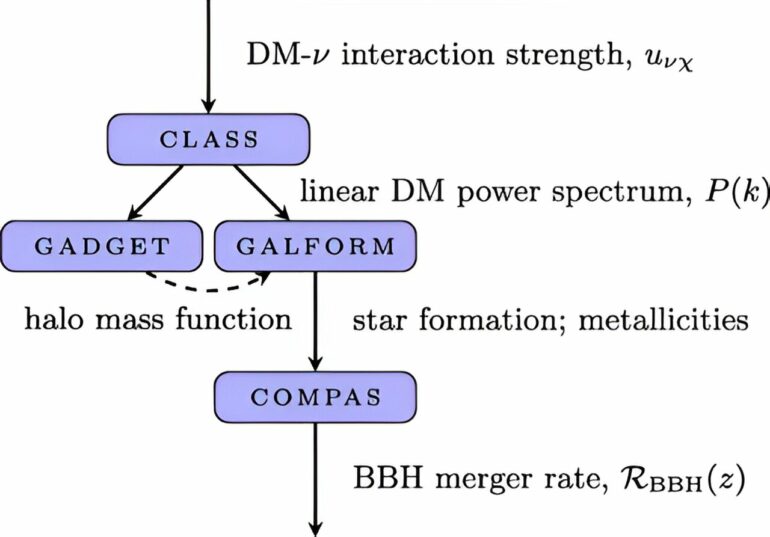Observations of gravitational waves from merging black holes may reveal new insights about dark matter, suggests a new study from a UCL-led international team.
The study, presented at the 2023 National Astronomy Meeting in Cardiff and now published in the journal Physical Review D, used computer simulations to study the production of gravitational wave signals in simulated universes with different kinds of dark matter.
Their findings show that counting the number of black-hole merging events detected by the next generation of observatories could tell us whether or not dark matter interacts with other particles and therefore help pin down what it is made of.
Cosmologists generally regard dark matter as one of the biggest missing pieces in our understanding of the cosmos. Despite strong evidence that dark matter makes up 85% of all the matter in the universe, there is currently no consensus on its underlying nature. This includes questions such as whether dark matter particles can collide with other particles such as atoms or neutrinos, or whether they pass straight through them unaffected.
A way to test this is by looking at how galaxies form in dense clouds of dark matter called haloes. If dark matter collides with neutrinos, the dark matter structure becomes dispersed, resulting in fewer galaxies being formed.
The problem with this method is that any galaxies that go missing are very small and very distant from us, so it’s hard to see whether they are there or not, even with the best telescopes available.
Rather than targeting the missing galaxies directly, the authors of this study propose using gravitational waves as an indirect measure of their abundance. Their simulations show that in models where dark matter does collide with other particles, there are significantly fewer black-hole mergers in the distant universe.
While this effect is too small to be seen by current gravitational wave experiments, it will be a prime target for the next generation of observatories that are currently being planned.
The authors hope their methods will help stimulate new ideas for using gravitational wave data to explore the large-scale structure of the universe, and shine a new light on the mysterious nature of dark matter.
Dr. Alex Jenkins (UCL Physics & Astronomy), one of the lead authors of the study, said, “Gravitational waves are a powerful new tool for observing the distant universe. The next generation of observatories will detect hundreds of thousands of black-hole mergers every year, giving us unprecedented insights into the structure and evolution of the cosmos.”
Co-author Dr. Sownak Bose of Durham University said, “Dark matter remains one of the enduring mysteries in our understanding of the universe. This means it is especially important to continue identifying new ways to explore models of dark matter, combining both existing and new probes to test model predictions to the fullest. Gravitational-wave astronomy offers a pathway to better understand not just dark matter, but the formation and evolution of galaxies more generally.”
More information:
Markus R. Mosbech et al, Gravitational-wave event rates as a new probe for dark matter microphysics, Physical Review D (2023). DOI: 10.1103/PhysRevD.108.043512
Provided by
University College London
Citation:
Gravitational waves may reveal nature of dark matter (2023, August 8)


